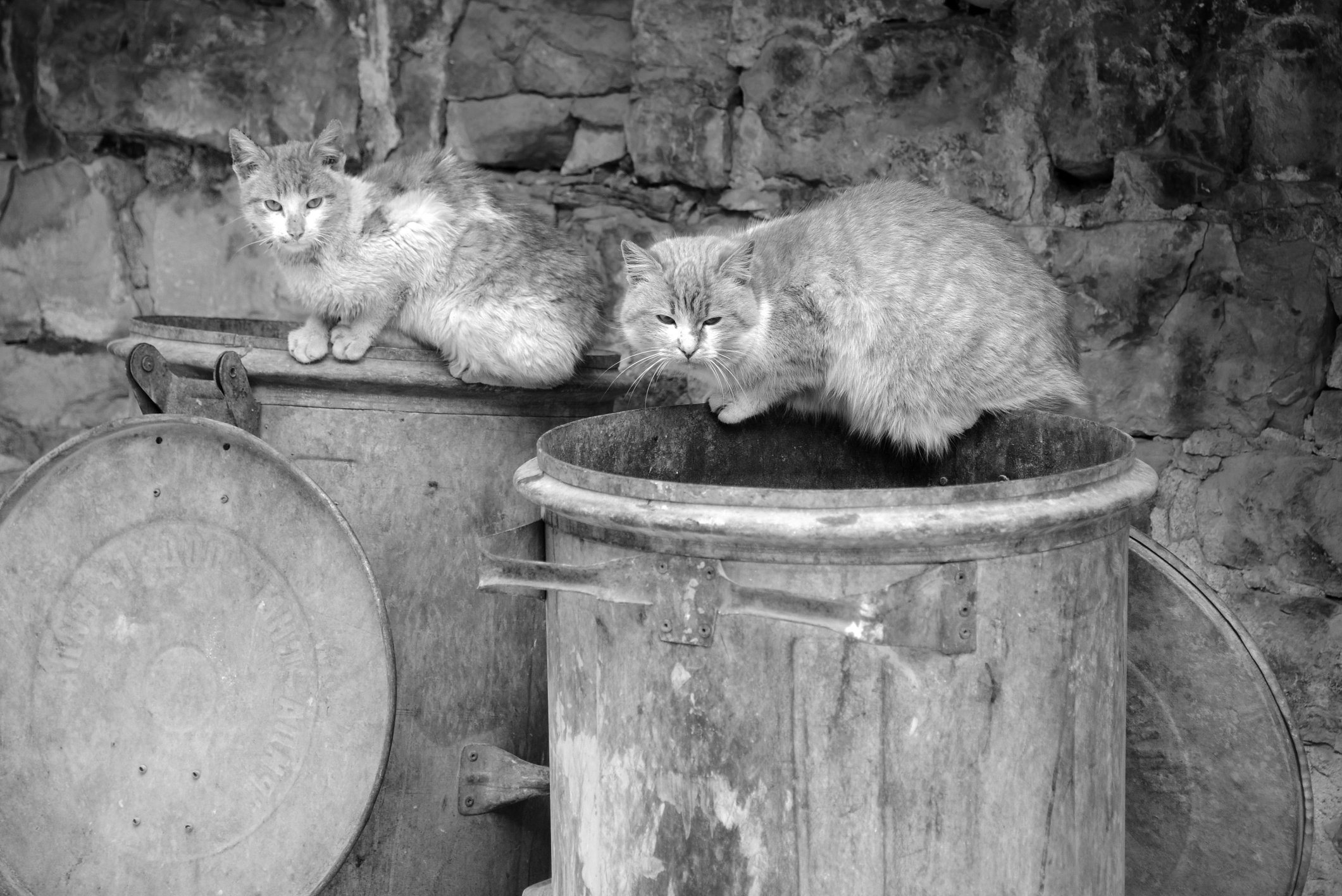A pile of cat feces in the corner of the dining room, urine-soaked carpets in a guest room closet — such discoveries get too many cats kicked outdoors for good, or surrendered to shelters. But it doesn’t have to be that way.
In their scrub-desert habitats in northern Africa, our cats’ ancestors buried their waste in the ubiquitous soft, sandy soil. Most cats take readily to a properly-prepared substitute for the desert sands: a litter box. Because litter box use is so natural for cats, it’s easy to forget that illness or unusual experiences can sometimes interrupt this behavior.
Most cats sail through life with perfect elimination manners, especially if their owners offer an ideal, cat-friendly selection of litter boxes that are convenient, safe, and rigorously maintained.
According to Nicole Cottam, MS, ACAAB, Behavior Service and Research Coordinator at the Tufts Cummings School of Veterinary Medicine, when it comes to litter boxes, simple is best: Establish multiple “litter stations” in quiet, convenient locations. Use large, open, uncovered boxes, one per cat plus one extra. Insure easy access with cutouts, ramps or steps. Fill with four inches of unscented soft clumping litter. Scoop at least once daily.
Don’t use “litter mats” that could possibly irritate sensitive paws. Think “destination resort” – the litter box should be a place where every cat feels safe, relaxed, comfortable and in control.
But even under the best circumstances, some cats just don’t take readily to litter box use, and some unexpectedly break training. Though these situations can be extremely frustrating, it’s helpful to remember that a cat always has a perfectly good reason — in his own mind — for avoiding the box.
It’s our job to figure out what the cat’s problem is, and to provide an effective, cat-friendly solution in tricky situations like these:
- A formerly outdoor or feral cat who has never used a litter box.
- A shelter adoptee whose experiences have not prepared him for the behavior expected in your home.
- A cat who has experienced pain, fright or illness in the box, and who now associates the litter box with his distress.
- A cat who is embroiled in an inter-cat conflict or is the victim of a “litter box bully” who is preventing him from using or accessing boxes.
- A cat who experienced a fright or unwanted surprise (such as a nearby furnace roaring to sudden life) while using the box, and now avoids it so the scary experience won’t be repeated.
- An elderly or infirm cat who starts missing the box because he can’t get to it in time, can’t remember where it is, or even what it’s for.
What To Do When You Notice Your Cat is Having Accidents
When you discover that a cat is using something other than a litter box for elimination, don’t panic. Put on your detective hat and get to work:
- Deny access to the soiled area. Close the door, or cover the soiled area with tinfoil (most cats hate walking on foil).
- Add one or more additional boxes in varying locations throughout your house.
- Clean and thoroughly deodorize the soiled area. Total cleanup is essential; the scent of the waste helps draw cats back to soiled areas.
- Observe all cats closely.
Identify Which Cat Stopped Using the Litterbox
It’s simple if you have only one cat, or you caught someone in the act. But in multi-cat families, fingering the guilty party (or parties) can be tricky. Vigilance and close observation of all cats over several days will probably reveal the culprit, or at least provide clues. Other ways to proceed:
Set up one or more “spy-cams” (“nanny-cams”) at locations that have been soiled. Have the feed sent directly to your browser or smart phone, or review the images later.
Ask your veterinarian about the possibility of using fluorescein dye. Administered to one cat at a time, it causes urine to glow green under fluorescent light.
You can invest in a “Spray Alert,” a product that sounds an alarm when a sensor material is sprayed, alerting you so you can determine immediately who’s responsible.
Every day the culprit remains at large means a reinforced bad habit for him, and a bigger cleanup job for you. Once you identify the culprit, get him to the veterinarian for a complete check-up. Meanwhile, confine him in a comfortable, private, easily-cleanable room with everything he needs. Offer at least one attractive litterbox (two is better) and see if he uses it.
Does he urinate in one box and defecate in the other? Or does he use the floor or other surface? If a cat who was a chronic misbehaver suddenly develops perfect manners in his private space, consider the possibility of inter-cat conflict or a bully.
Litter Box Bullies
Some bullies pick on only one particular cat; others strive to prevent all cats from accessing boxes. Make any bully’s “job” tougher by placing litter boxes in several different areas of your home; a bully can’t be in two places at once.
Thinkstock

Once you’ve identified a bully, place him in the private room, and let the originally-misbehaving cat out. If that cat now resumes his perfect manners, work on addressing the bully’s problems.
Why is the bully acting this way? It may be territorial stress; insecurity drives him to hog resources for himself. Adding additional litter boxes, and addressing the underlying causes of the bully’s stress, can help. Consult your veterinarian about giving the bully a course of stress-reducing medication.
Cats Who Never Learned the Litterbox Rules
Newly-adopted young cats and kittens usually follow their elders’ lead and quickly figure out litter box rules. Adult shelter cats, or cats who have lived exclusively outdoors, might need more patience and persuasion. For adult cats who were caged in shelters, a litter box may carry unpleasant associations, and be something to be avoided. Because many caged shelter cats hide or sleep in their boxes, they may not clearly see the box as the ideal spot for elimination.
Thinkstock

The shelter may have used a filler that’s different, in texture, scent or paw feel, from the kind you use. On homecoming, install the cat in a temporary private space furnished with at least two boxes: one filled with his familiar litter, and one filled with your home litter. Over the course of several days, gradually switch over to all home litter. Watch his behavior. Let him join the rest of your cat family only after he’s been reliably using the box for several days.
When the Cause Remains Unclear
For cats who (you suspect) have experienced a fright or unpleasant surprise in the box, move boxes to locations where it’s least likely that bad experiences will be repeated. Make sure all cats are still using their boxes faithfully. A cat who’s avoided the boxes for an extended time may need a few weeks of isolation in a private space, followed by gradually-increased freedom, to help reestablish proper etiquette. It might be wise to throw out the old box(es) and start fresh, to more definitively break any bad associations.
In the end, it’s not always possible to determine just why a cat stops using the box, or has trouble getting the hang of it. The best course is to be a “good provider:” offer a rich array of cat-attractive boxes in various locations. Closely monitor the cat’s behavior until he “gets it.”
The keys to diagnosing and solving litter box lapses are patience, vigilance, careful observation and detective work, and — most importantly — immediate action. And remember that urinary tract diseases are an important potential cause of litter box problems, and should be ruled out by a veterinarian early in the process. Litter box problems don’t solve themselves, but they can be solved.




